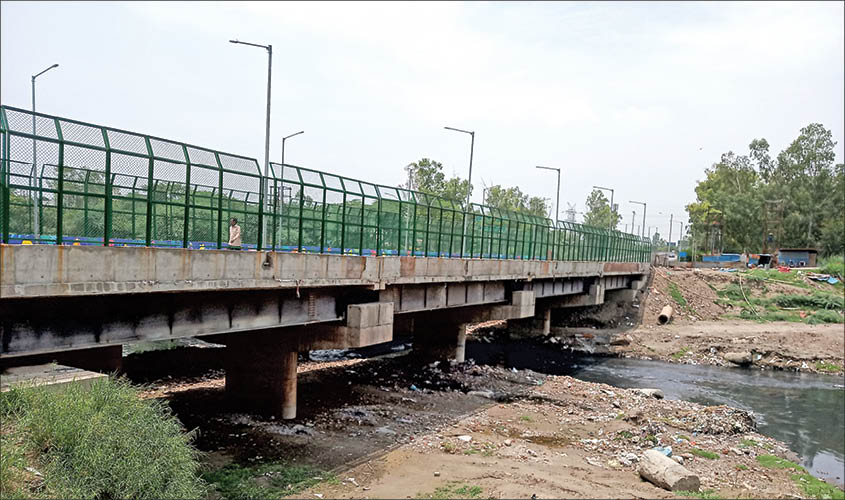New Delhi: On 5 July the last section of the bridge on Shahdara drain was thrown open to the public, bringing much cheer to motorists commuting between East Delhi and Noida. But the upper-middle class families who have been living in the drain’s vicinity for decades were not impressed.
As Subhankar Maity, the resident of an East Delhi residential society, said: “People wake up early to fill their lungs with fresh air. But here, every morning residents have to wake up to the smell of toxic gases emitting from Shahdara drain.”
The Shahdara drain, created in 1976, was originally meant to be a canal to carry floodwater from the Yamuna bed. But for the past several decades, the canal has been reduced to a drain carrying sewage. The Shahdara drain, which starts from GT Road near Seelampur in East Delhi and ends at Noida, Sector 92, carries sewage from Ghazipur, Mandawli, Kondli, Kalyanpuri, Gharoli, Yamuna Vihar and Mustafabad, among others.
In 2016, Amina Hussain, a resident of East End Apartment in East Delhi, started the “Cover the Drain” campaign. Though she withdrew her campaign within a few months but it received a huge response both from residents and AAP MLA Atishi Marlena. In fact, a campaign to get the drain covered has been going on for several years. According to P.J.B. Khurana, the president of Mayur Kunj Residents’ Welfare Forum (RWF), “For the past 15 years we have been fighting to get the drain covered. We have written numerous letters to the civic bodies, but nothing has been done till date. The Sheila Dikshit government had proposed another Dilli Haat on this stretch, which never saw the light of day. Now the AAP government has proposed constructing a road on top of the drain up to Mahamaya flyover in Noida. As this road is supposed to be at a lower height than that of Barapullah flyover, hence, it would not serve any purpose of reducing the stench from the drain. ”
The continuous emission of toxic gases from the drain is damaging the household appliances of local residents. Kailash Vavehra, the secretary of East End Apartment, said: “Every year we have to refill or repair our air conditioners or refrigerators twice.” However, it is the health hazard that worries them the most.
Subhankar Maity, who lives in East End Apartment, said, “Because of the continuous emission of toxic gases, people are having lung problems in our apartment. Around five people suffered kidney damages.” To this, Gunjan Jha, another resident, said, “My brother, who is neither a smoker nor a drinker, is one of them. When he visited the doctor he was asked if he lived near a drain.”
The campaign to “cover the drain” faced the red light when in 2014 the National Green Tribunal (NGT) said that drains could not be covered. The NGT said covering drains would be like a bomb waiting to explode. The NGT report also said that covering drains would result in increased toxicity and health hazards because of the trapped gases. The report concluded that covering a drain had “the potential to cause environmental damage by changing the local biodiversity and hampering with their environmental functions”.
While Gunjan Jha said that closing the factories that released toxic sewage into the drain was the only solution, P.J.B. Khurana, the president of Mayur Kunj RWF said that the capacity of the nearby sewage treatment plant (STP) should be increased to tackle the problem. “After several petitions were filed, finally two sewage treatment plants (STPs) were constructed along the drain. The STP at Kalyanpuri is 70 MGD (million gallons per day) capacity, while the one at Chilla Regulator is 9 MGD. And yet the drain continues to emit the stench that it did before 2016. As the STP in Chilla Regulator is treating the water from both Shahdara drain and Hindon river, the quantity of treated water released is microscopic when compared to the gallons of toxic water that comes into Shahdara drain.” Khurana said.
The drain is also where mosquitoes breed rampantly. As Dinesh Sehgal, president of the nearby Indian Express Apartment, said, “Whenever officials come to our houses to inspect the breeding of dengue mosquitoes we show them the ‘actual’ ground where mosquitoes breed.”
In January the Central Pollution Control Board had asked the Delhi government to ensure that no garbage was dumped or burnt near the Shahdara drain. And yet garbage continues to flow freely into the drain. The situation is so critical that many long-time residents are shifting out of the area and taking up residence in other parts of the city or in NCR. The rest residing in Mayur Kunj and East End Apartment are trying to fight it out by planting more trees near the drain to dilute the toxic smell.

